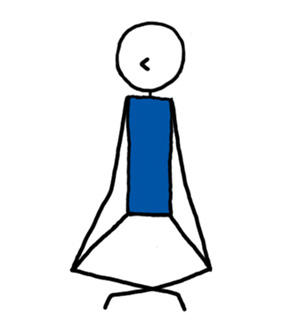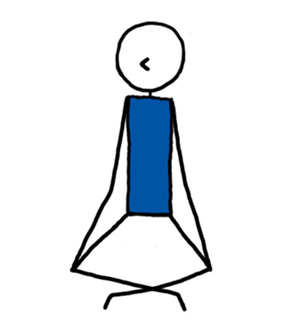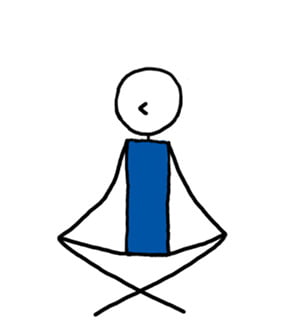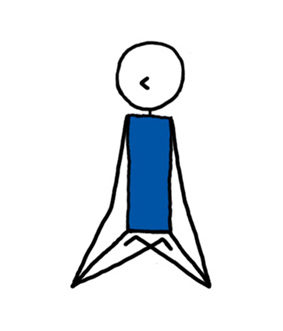
| Category: | Yoga Lesson Planner |
|---|---|
| Sub Category: | Mantras |
| Types: | Seated, Seated & Floor |
| Anatomy: | Core, Hamstrings, Hips, Psoas |
| Chakras: | Crown Centre, Third Eye |
| Therapy: | Anxiety, Depression, Eye fatigue, Fatigue, Headaches, Insomnia, Stress |
| Drishti: | Eyebrow |
| Dosha: | Kapha, Pitta, Vata |
| Meridian Lines: | All Meridians |
Version I: "Ham. Sa. So. Ham. Shivo. Ham." Pronunciation: "hahm sah soh hahm shee-voh hahm". Translation: signifies the unity of the individual self with the divine consciousness of Lord Shiva, harmonizing with the natural rhythm of the breath. Version II: "Om tryambakam yajamahe sugandhim pushtivardhanam; Urvarukamiva bandhanan mrityor mukshiya maamritat." Pronuciation: "ohm try-ahm-bah-kahm yah-jah-mah-hay su-gahn-dheem poosh-tee-var-dhah-nahm; oor-vah-roo-kahm-ee-vah bahn-dhah-nahn mri-tyor mook-shee-yah mah-am-ri-taht." Translation: Worshipping Lord Shiva, the three-eyed nourisher, we seek liberation from death and the gift of immortal nectar.
Improved concentration. Stress reduction. Self-awareness. Emotional healing. Boosted immune system. Increased energy levels. Deeper spiritual practice.
A) Sit on a bolster, folded blanket, or block. B) Sit against a wall. C) Sit in a chair. D) Change the cross of the legs. E) Sit in Hero, Perfect or Lotus pose.
Be clear about intention when chanting mantras.
Click here for lots of FREE downloadable Yoga lesson plans.
Click here for lots of FREE downloadable Pilates lesson plans.
- 7 Mantras: Practice 1 A Day For 7 Days
- Ask Genie4
- Ask Genie1
- Mantras
- mantra 1
- Ask Genie1
- Ask Genie2
- Ask Genie1
- Ask Genie2
- Mantras
- Ask Genie5
- Ask Genie1
- Ask Genie4
- Mantras
- Ask Genie2
- Ask Genie17
- mantrasandother
- Ask Genie2
- Ask Genie2
- 7 Mantras: Practice 1 A Day For 7 Days
- Ask Genie6
- Ask Genie 1
- Ask Genie 8
- Ask Genie 12
- Ask Genie 1
- Ask Genie 1
- Ask Genie 4
How to Teach Lord Shiva Mantra
Here’s a bit of background to give to your students about the mantra:
Lord Shiva is one of the principal deities in Hinduism and is considered the supreme being who destroys and transforms the universe. He is a part of the holy trinity, which also includes Brahma (the creator) and Vishnu (the preserver). Lord Shiva is revered for his power, wisdom, and compassion and is associated with the principles of destruction, regeneration, and meditation.
There are several mantras dedicated to Lord Shiva, each with specific intentions and benefits. One of the most well-known and powerful Shiva mantras is the Maha Mrityunjaya Mantra. This mantra is believed to bestow longevity, prevent untimely death, and provide protection from various forms of suffering and negative energies.
Maha Mrityunjaya Mantra:
“Om tryambakam yajamahe sugandhim pushtivardhanam; Urvarukamiva bandhanan mrityor mukshiya maamritat.”
Next up, is the translation.
Lord Shiva Mantra Translation
The long translation of this mantra is:
“We worship the three-eyed one (Lord Shiva), who is fragrant and nourishes all beings. May he liberate us from the bondage of death, like the cucumber is severed from its attachment to the vine, and grant us the nectar of immortality.”
The short translation of this mantra is:
Worshipping Lord Shiva, the three-eyed nourisher, we seek liberation from death and the gift of immortal nectar.
Next up, are the benefits.
Lord Shiva Mantra Benefits
Chanting the Maha Mrityunjaya Mantra is believed to have numerous benefits, such as promoting physical, mental, and emotional healing, cultivating spiritual growth, and warding off negative energies. Regular recitation of the mantra is said to create a protective shield around the practitioner and helps them overcome fears and obstacles in their lives.
Next up, is the pronunciation.
Lord Shiva Mantra Pronunciation
Here is the mantra without pronunciation:
“Om tryambakam yajamahe sugandhim pushtivardhanam; Urvarukamiva bandhanan mrityor mukshiya maamritat.”
Here is the pronunciation for the mantra:
“ohm try-ahm-bah-kahm yah-jah-mah-hay su-gahn-dheem poosh-tee-var-dhah-nahm; oor-vah-roo-kahm-ee-vah bahn-dhah-nahn mri-tyor mook-shee-yah mah-am-ri-taht.”
Here is a breakdown of the pronunciation:
Om: “ohm”
tryambakam: “try-ahm-bah-kahm”
yajamahe: “yah-jah-mah-hay”
sugandhim: “su-gahn-dheem”
pushtivardhanam: “poosh-tee-var-dhah-nahm”
Urvarukamiva: “oor-vah-roo-kahm-ee-vah”
bandhanan: “bahn-dhah-nahn”
mrityor: “mri-tyor”
mukshiya: “mook-shee-yah”
maamritat: “mah-am-ri-taht”
Well done! Keep repeating it over and over again. Imagine you’re the famous singer of Mantras, Diva Premal, and sing the mantra (out loud or silently).
Next up, is how to practice the mantra.
How to Practice Lord Shiva Mantra
To practice the mantra, sit comfortably in a quiet space with your spine erect. Take a few deep breaths to calm your mind and body. Focus your attention on the base of your spine, and begin to chant the mantra aloud or silently. You can repeat the mantra as many times as you feel comfortable for 5 to 15 minutes.
Next up, is one of the different variations of the mantra.
Try this Different Version of the Lord Shiva Mantra
Repeat this mantra:
“Ham. Sa. So. Ham. Shivo. Ham.”
As you breathe in repeat in your mind: HAM.
Slight pause.
As you breathe out repeat in your mind: SA.
As you breathe out repeat in your mind: SO.
Slight pause.
As you breathe in repeat in your mind: HAM.
As you breathe out repeat in your mind: SHIVO.
Slight pause.
As you breathe in repeat in your mind: HAM.
The mantra is a combination of the Soham and Hamsa mantras, with the addition of “Shivo Ham.” Soham (or So’ham) and Hamsa (or Ham’sa) are two variations of the same mantra, representing the unity of the individual self with the universal self. They are called ajapa-japa mantras, which means that they are “unspoken” or “unsaid” mantras, as they reflect the natural sound of the breath.
Soham = “I am That” (I am the universal Self).
Hamsa = “That I am” (That universal Self is me).
Ham represents the inhale.
Sa represents the exhale.
Shivo Ham = I am Shiva.
Next up, are several free yoga philosophy lesson plans.
Free Yoga Philosophy Lesson Plans
As a yoga teacher, you know that yoga is much more than just a physical practice. It is a holistic approach to health and well-being that includes mental, emotional, and spiritual elements.
One of the fundamental aspects of yoga is its philosophy, which provides a framework for understanding the nature of reality, the human condition, and the purpose of life.
However, teaching yoga philosophy can be challenging, especially if you want to make it engaging and accessible to your students.
In this blog post, I share ten creative yoga philosophy lesson plan ideas (including the Eight Limbs Of Yoga, Purusha, Prakriti, and The Yoga Sutras) that will help you bring this essential aspect of yoga to life in your classes.
Next up, are the benefits of chanting, repeating, or meditating upon a mantra.
10 Benefits of Practising Mantras
Mantras offer various physical, mental, and spiritual benefits, including:
Cultivate Concentration: Chanting mantras can help calm the mind, improve concentration, and sharpen focus, making it easier to stay present during meditation or daily activities.
Stress Reduction: Repeating mantras can help lower stress levels by inducing a relaxed state and calming the nervous system.
Self-awareness: Mantra meditation can promote greater self-awareness and introspection, helping you better understand your thoughts and emotions.
Emotional Healing: Chanting mantras can help release emotional blockages, facilitate emotional healing, and promote inner peace and balance.
Boosted Immune System: The vibrations created by chanting mantras can stimulate the release of hormones that boost the immune system, promoting overall health and well-being.
Increased energy levels: Mantra meditation can help balance and energize the body’s chakras, leading to increased vitality and energy levels.
Spiritual Growth: Mantras can help you connect with your inner self, fostering spiritual growth and deepening your spiritual practice.
Improved Communication: Chanting mantras can strengthen the vocal cords and improve speech clarity, making it easier to communicate effectively with others.
Positive Vibrations: Mantras create positive vibrations that can transform negative energy, cleanse the environment, and uplift the mood.
Enhanced Memory: Regular practice of mantra meditation can improve memory, cognitive function, and overall brain health.
Next up, are different ways to sit in Easy Pose (Sukhasana).
Easy Pose (Sukhasana) Modifications
Here are some modifications to make sitting in Easy Pose (Sukhasana) more comfortable:
Sit on a bolster, folded blanket, or block: Elevating the hips can help maintain the natural curve of the lower back, making it easier to sit upright and reducing strain on the hips and knees.
Place a folded blanket or cushion under the knees: If the knees are elevated higher than the hips, supporting them with a blanket or cushion can reduce tension in the hip flexors and groin area.
Adjust foot placement: If crossing the ankles is uncomfortable, try placing one foot in front of the other instead of fully crossing the legs.
Sit against a wall: For additional support and to help maintain proper posture, you can sit with your back against a wall.
Use a chair: If sitting on the floor is too challenging, you can sit on a chair with your feet flat on the ground and knees bent at a 90-degree angle. Place a cushion or folded blanket on the chair for even more comfort.
Take breaks: If sitting in Easy Pose becomes uncomfortable, take breaks to extend the legs or change the cross of the legs.




 Yoga Lesson Planner
Yoga Lesson Planner
 Pilates Lesson Planner
Pilates Lesson Planner









